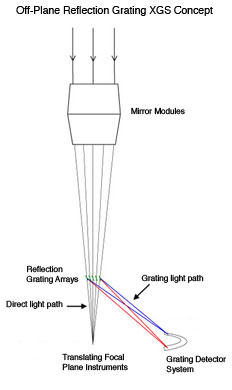 |
Goddard Space
Flight Center NASA > GSFC > Astrophysics Science Division > IXO |
|

You are here: Technology» XGS»
The IXO X-ray Grating Spectrometer (XGS) is a wavelength-dispersive spectrometer that will provide high spectral resolution in the 0.3–1.0 keV band. XGS key performance requirements include spectral resolving power (λ/Δλ) of 3000 (FWHM) and effective area larger than 1000 square cm across its operating band. This spectrum in the soft x-ray band can be used to determine the properties of the warm-hot-intergalactic medium, outflows from active galactic nuclei, and plasma emissions from stellar coronae. See IXO Science Performance Requirements.
The XGS will intercept and disperse a fraction of the beam from the mirror onto a charge-coupled device (CCD) camera. It will operate simultaneously with the observing MIP instrument and collect instrumental background data which can occur when an instrument is not in the focal position. See also the XGS on the Instrument Module.
To achieve high-resolution spectroscopy, the XGS will consist of an array of wavelength-dispersive diffraction gratings with a fine pitch of 5000 lines/mm or more. This will intercept the converging X-ray beam exiting by the Flight Mirror Assembly (FMA) and disperse it to a series of CCD detectors. An array of CCDs (9–32, depending on the grating technology) used in photon-counting mode will be employed to image and read out the dispersed spectra. The CCD detectors provide better than the 80 eV resolution required for separation of the multiple diffraction orders produced by both kinds of gratings.
Currently, there are two technologies under consideration for the XGS – critical-angle transmission gratings (CAT gratings) and "off-plane" reflection gratings:


Diagram showing the geometry of the two concepts for the XGS: a transmission grating (left) and an "off-plane" reflection grating (right). In both images, red and blue lines indicate the light path for the grating instrument. Black lines indicate the direct light path through the instrument (light that is not intercepted by the gratings). This direct light path leads to the focal plane instruments, such as the X-ray Microcalorimeter Spectrometer and Wide Field Imager. Click images for larger view